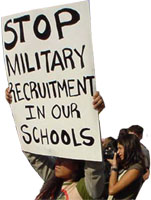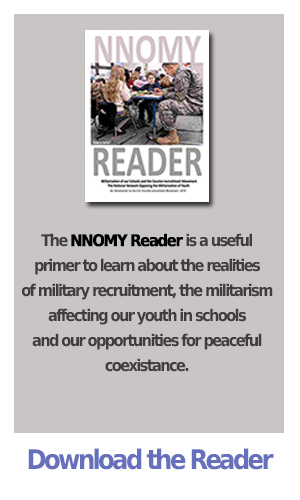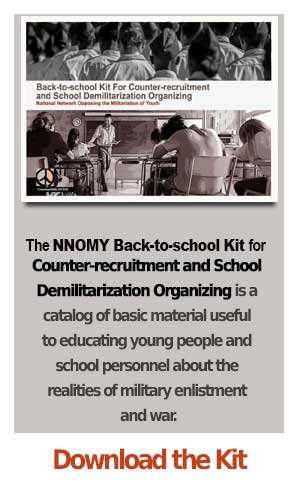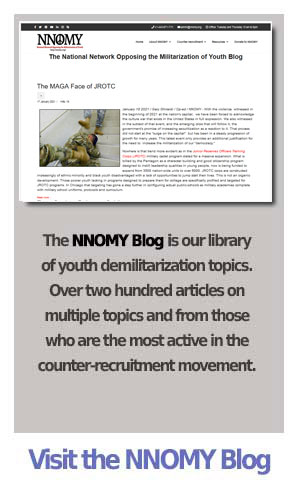ORGANIZING A STATEWIDE CAMPAIGN TO REQUIRE OPTION 8
A tutorial
This step-by-step guide is meant to aid activists in their legislative campaigns to prohibit the automatic release of test results to military recruiters gathered through the administration of the Armed Services Vocational Aptitude Battery (ASVAB) in the public high schools.
The steps outlined here, largely drawn from our experience in Maryland, can be used as a general template for counter-recruitment activists across the country.
We recommend you study everything on this site pertaining to the ASVAB (including a cursory examination of military documents) and read through the entire contents of this comprehensive website: http://www.asvabtest.org/ before proceeding. Study is critical because much of this campaign revolves around educating school officials, political allies, and legislators. The military, for its part, has embarked on a very clever and persuasive misinformation campaign. See the "ASVAB in the News" section of the http://www.asvabtest.org/ website for more on DoD attempts to obfuscate the true nature of the ASVAB program in the public schools.
(Update: Not the case in September 2022: See ASVAB Enlistment Testing Program)
The first step is to form a loose-knit coalition of allies and give it a name that has something to do with protecting the privacy of children; like, "The ________ Coalition to Protect Student Privacy." "Peace" and "Justice" are polarizing words in statehouses across the country so you'll want to be careful not to associate your campaign with activist groups that might insist on asserting an anti-military or left-wing agenda.
You'll run across school officials and legislators who are convinced the ASVAB is an excellent career exploration tool that has its place in the public schools. Concede the point. You can allow that the program might help young people negotiate career paths. You're not against the ASVAB; however, you feel strongly that test results should not be automatically forwarded to military recruiters.
Once you've formed your "coalition," which may start out as a couple of activists in town (or just yourself), you'll need to begin building your coalition by contacting your natural allies in this struggle. Call your local ACLU affiliate and ask them for advice. See if they can help you craft legislation. Ask them who they think might be willing to introduce the bill in your state's House and Senate. Send them the excellent letter written by the ACLU-MD in support of Maryland's legislation. You should also send them Maryland's new law.
Your state is likely to have some sort of institutionalized progressive political entity like a progressive Democratic caucus. Contact them and see if they can help. They're likely to be in a position to know which legislators are the best candidates to carry the water. Be careful not to fall into the trap of agreeing to have the legislature's most progressive member, the token radical, be the lead sponsor. You're going to need conservative Democratic votes and even a few Republican votes.
In your conversations with these folks, try to determine the likely path your legislation will have to travel to make it to the governor's desk. Identify the specific committees and subcommittees you'll most likely be dealing with and examine the voting records of members before approaching them or having others approach them. It's very helpful to have co-sponsors sit on crucial committees. It's a real coup to have a committee chairperson agree to sponsor or co-sponsor the bill! Committee chairs are often incredibly powerful and it's tough (though not impossible) getting legislation to the floor if they're strongly opposed.
Call your local NAACP Unit (archived) and ask them for their advice and support. Do a cursory evaluation of the ASVAB Database of high schools that administer the test in your state. Try to ascertain the racial make-up of schools that administer the ASVAB. The ASVAB is more likely to be administered in communities of color than in predominately white areas. Share the testimony of the NAACP-MD urging parental involvement in decisions relating to the release of student information to the Pentagon.
You should call your state affiliate of the National PTA. In Maryland, the PTA came through in a big way. During the PTA testimony in the General Assembly, a PTA spokesperson argued that parents, rather than the Pentagon, should be empowered to make decisions regarding the release of student information to recruiters. In contrast, the Army's top recruiter argued that the Pentagon should make these decisions, rather than "influencers," DoD talk for parents.
You should also contact your NEA state affiliate (archived) to see if they'd be willing to support your legislation. The National Education Association has not taken a position on the ASVAB, although a piece in the publication NEA Today describes the controversy and explains Options 1 through 8. NEA leadership has explained that the issue is not specifically related to the NEA's purview.
It is advisable to send a letter to your state superintendent of schools asking that she immediately select Option 8 for all students across the state who take the ASVAB. See the Template Letter to State Superintendents. It is unlikely that your state superintendent will act to mandate this change because these types of decisions are typically left to local education agencies. It is important, however, to know where this office stands in relation to your legislation. Your legislature will be reluctant to enact legislation if it is opposed by the state superintendent. If your superintendent takes no position on your bill, it may be viewed as a green light in some quarters.
Getting a bill introduced
Throughout this process, you should be seriously considering whom you'd like to ask to submit legislation. It may be helpful to have a constituent of a legislator make an appointment and have you attend the meeting. Legislators are much more willing to act on behalf of people who live in their districts. Once you've settled on lawmakers in both houses to sponsor your legislation, it's advisable to hold a strategy session to formulate a plan of action. Your legislator is likely to ask you to help her find co-sponsors for the legislation. For instance, see Maryland's House Bill 176 and view the delegates who were willing to sign on to the bill before it was introduced.
Once your bill is introduced, there may be a window of time when you're still able to add additional co-sponsors. It is best not to have too many legislators from one or two extremely liberal jurisdictions co-sponsor the bill because it may be viewed by moderates to signify a left-wing proposal. If possible, try to find a few Republicans to sign on.
Leave the press out of it. There's no point in giving your opposition a heads up.
Your bill will be assigned to committees in each house that will schedule hearings. Obtain a list of committee members and send them each a letter similar to the letter sent to the superintendent of schools. Include in the letter the names of all of the public schools in the legislative district that administer the ASVAB, along with the Recruiter Release Options selected. Most likely, the vast majority of students who took the test in the particular jurisdiction had their test results automatically forwarded to recruiters. Note that you're only concerned with public schools that administer the test. You'll have to create a spreadsheet of all the schools in your state that give the test and remove the private schools before sorting them into legislative districts to generate letters to individual lawmakers. You should deliver your letter by regular mail, by email, and you should hand carry it to the office of each committee member.
It is also advisable to create succinct bullet points and distribute them to lawmakers on several occasions. You can never overdo it. Educating lawmakers is your key to success.
At this point, you should schedule appointments to meet with all committee members. This part is time consuming, but it is possible to meet with as many as 10 to 15 legislators in a day. You'll only need about 20 minutes of their time. Go over the bullet points with the legislators and discuss how the test is given at such-and-such high school in the particular district. See if you can find folks from various peace and justice groups or through your contacts with the organizations listed above who would be willing to accompany you in the meetings. Again, it helps, although it is not necessary, to have constituents make the appointments and accompany you to the meetings.
Legislation is made in committees and it is rare for a bill to receive a favorable report in committee and be voted down on the floor.
Lobbying for the bill
We strongly encourage you set up an automated system that allows constituents across your state to click on a link that brings them to a page that briefly explains the issue and guides them through a simple process that generates letters of support to their legislators. Activists in Maryland were able to generate close to a thousand emails, with many directed to committee members whose votes were crucial. Your political allies may be willing to share contact information with some of their membership. Phone calls from constituents to committee members are invaluable in this process. It helps to regularly send messages to list-serves, blogs, websites, and Facebook, sending people the link to the automated system to generate emails to lawmakers.
When a bill is heard in committee, those in favor and those opposed are invited to provide written and spoken testimony. Speakers are usually limited to a few minutes. It is possible that the militarists will not be present to oppose the legislation, especially if the measure has stayed out of the press. It's possible your bill may attract a letter from the commanding officer of your local Military Entrance Processing Station, as it did in Maryland. This could be helpful because the military is arguing that the Pentagon, rather than parents, should ultimately determine the release of student information. Activists in Maryland circulated the letters written by the Maryland PTA, which argued in favor of allowing parents to make decisions regarding the release of information pertaining to their children, and the Lt. Colonel in charge of recruiting, who didn't think that was such a good idea. Most legislators were convinced the measure was necessary and the law passed.
A good lineup of people testifying in committees hearing the bill would consist of an official from a school or a school system that has selected Option 8 and representatives from the NAACP, ACLU, PTA, your local teacher's union, your state's progressive political entity, a student who has taken the ASVAB without realizing its tie-in with recruiting, and an unhappy parent. You should lead the parade.
As soon as a committee in one of the houses approves the measure, you ought to distribute a brief statement to all legislators in both houses that includes a mention of the victory along with a few of the most pertinent bullet points.
At this point, the Pentagon and its allies in the legislature may be expected to engage in a behind-the-scenes public misinformation campaign aimed at questioning the necessity of the Option 8 bill.
They may argue that Section 9528 of the No Child Left Behind Act gives parents and students the ability to withhold ASVAB test results from military recruiters. It does not.
The militarists may argue the ASVAB program is completely voluntary and that students who take the test can sign a form that precludes their results from reaching recruiters.
The test may, in fact, be required in some schools and/or strongly encouraged in others, but, in either case, results are being automatically shipped to recruiters. Also, the bogus Privacy Act Statement found on the ASVAB Answer Sheet in use in schools throughout the country informs students they must sign the form for their test to be graded. Legal experts claim this aspect of the testing regime runs counter to both federal and state laws designed to protect the privacy of students. Students who take the ASVAB do not select release options — only school officials can do that.
Once the legislation passes its assigned committees and is sent to the floor for a vote, it is crucial to continue sending all members relatively brief items that address the legislation. If there are any new letters in opposition, they should be widely distributed and all misstatements should be identified. Similarly, erroneous reporting in the press should be immediately challenged with letters to the editor that are shared with legislators.
During this fragile time period, it's important to be working closely with those who've sponsored your legislation. Sometimes they'll ask you to refrain from contacting a particular member or to refrain from sending literature. Generally, you should defer to their wishes. They know the legislature. You know the ASVAB.
As soon as the legislation is introduced, you should make an appointment to meet with the governor's legislative assistant to explain the rationale behind the bill and to ask for the governor's support. When the legislation passes both houses, it is wise to make a second appointment with the governor's office. If the governor appears to be wavering in her support, you should generate hundreds of letter in support of the legislation.
At any time you may consult with NNOMY for advice. This is a winnable campaign!
Revised: 09-21-2022


 Equal access refers to the lawful activity of countering military recruitment inside high schools. It is not the only way to reach and educate young people who are targeted for military recruitment, but it is an effective way to counter military recruitment where it is having a major impact.
Equal access refers to the lawful activity of countering military recruitment inside high schools. It is not the only way to reach and educate young people who are targeted for military recruitment, but it is an effective way to counter military recruitment where it is having a major impact. The military has maximized its presence and influence in the educational system by seeking the widest possible access to classrooms, school career centers, counseling offices, student records, student newspapers and even elementary school playgrounds.
The military has maximized its presence and influence in the educational system by seeking the widest possible access to classrooms, school career centers, counseling offices, student records, student newspapers and even elementary school playgrounds.




